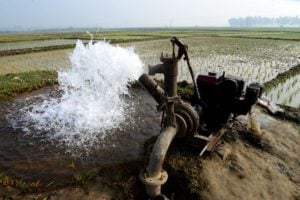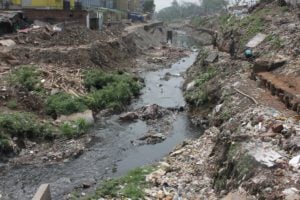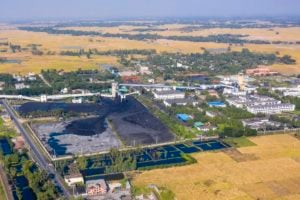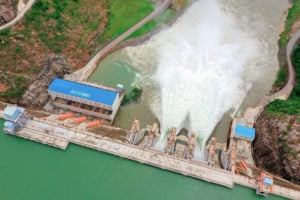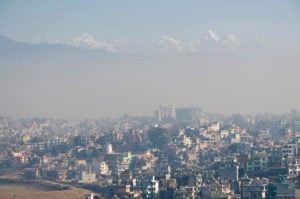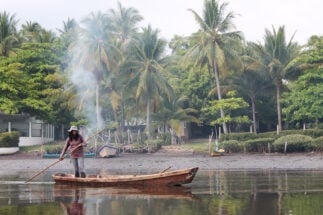Every morning, Abdul Aziz wakes up before dawn in the shack he shares with his wife and two daughters. Pedalling rickshaws through the streets of Dhaka is the only way the 50-year-old can provide food for his family now.
Aziz lives in Korail, the largest slum in Bangladesh’s capital. The slum is home to nearly 200,000 people, most of whom have been displaced by the impacts of climate change.
Aziz used to live in Sylhet, in northeastern Bangladesh, where he grew rice and raised cattle. But a sudden flash flood and subsequent inundation in May 2022 impacted him, along with over 4.3 million others. The floods washed away his property, including four cattle. With nowhere to live and no means of earning a living, he and his family ended up in the Korail slum.
The slum is overcrowded and squalid, with poor sanitation, access to clean water and drainage. The average slum house is around 100 square feet in size and consists of just one room.
Cyclones uproot 110,000 people every year in Bangladesh, while on average flooding displaces a million people, according to the Internal Displacement Monitoring Centre. In addition, two-thirds of the country is less than 15 feet above sea level, making sea-level rise an increasing threat.
“Every day 2,000 people move to Dhaka, 70% of them due to natural disasters and climate change. The city is struggling to cope with the pressure of the migrants,” Atiqul Islam, mayor of Dhaka North City Corporation, told Unbias The News.
Every day 2,000 people move to Dhaka, 70% of them due to natural disasters and climate changeAtiqul Islam, mayor of Dhaka North City Corporation
In Chittagong, Nur Nahar Begum lives with her four children and husband in informal dwellings next to the Karnaphuli River. The family migrated to the city from Laxmipur, a low-lying southeast coastal district, after they lost their home to river erosion in 2019.
Bangladesh’s second-largest city is projected to experience a high rate of internal migration. It is estimated that 15,000-30,000 people will migrate every year within the Chittagong district due to increasing soil salinity from sea-level rise.
The 5,000 slums in Dhaka are home to four million people, while Chittagong’s 200 slums house 1.4 million.
Dhaka is sinking
Both Aziz and Begum tried to move to safer ground. However, Dhaka and Chittagong are already suffering from land subsidence.
Saleemul Huq, climate scientist and director of Dhaka-based research organisation the International Centre for Climate Change and Development, said that Dhaka is subsiding for two main reasons: groundwater extraction and loss of wetlands.
“The wetlands that used to be part of areas of Dhaka have shrunk considerably over the last 20-30 years. As a result, the water used to recharge the groundwater is no longer recharging groundwater. This increases the subsidence rate of the city,” Huq said.
Data from the Dhaka Water Supply and Sewerage Authority (DWASA) shows that in 1963, when the population of Dhaka was less than a million, the DWASA supplied 130 million litres of water a day (MLD). This was groundwater extracted with 30 deep tubewells (DTWs).
Dhaka now provides 2,590 MLD per day to its over 20 million residents. Today, it has 906 deep tubewells, along with five water treatment plants. About 4,000 households also get water from their own deep tubewells.
Groundwater extraction has contributed to the depletion of the water table in Dhaka. In 1960, water was usually found within 20-30 metres. According to Taqsem A Khan, managing director of the DWASA, now DTWs have to extract at depths of hundreds of metres, “which is increasing every year”.
Anwar Zahid, director of groundwater hydrology at the Bangladesh Water Development Board, said: “The groundwater level in Dhaka city areas is decreasing very sharply with annual decline rates of 1.5 to 2.11 metres every year.”
“Subsidence is common for geological and tectonic reasons,” said Syed Humayun Akhter, a geologist and vice-chancellor of Bangladesh Open University. “But it occurs at a very low rate, around 3 mm yearly. Analysing the data from the GPS set at Dhaka University geology department, we found that subsidence is happening at an alarming rate of around 12 mm per year in Dhaka… Lifting excessive groundwater mainly causes the land subsidence in Dhaka, though sea level rise and waterlogging are also responsible. If the subsidence goes at such a rate, it will be differential subsidence, which means subsidence takes place at a different rate at different points. It poses danger – to Dhaka and its buildings – as this creates imbalance.”
Industry and people compete for water in Chittagong
Chittagong has been identified as one of the coastal cities in Asia subsiding almost 10 times faster than the sea level is rising. It sank by as much as 20 millimetres per year between 2015 and 2020.
The city, often described as the country’s commercial capital, also has a groundwater extraction problem. Before 2010, the Chattogram Water Supply and Sewerage Authority (CWASA) supplied 190 million litres per day, of which 100 MLD was taken from underground aquifers.
CWASA chief engineer Maksud Alam said that since 2017, 92% of the city’s water has been sourced from surface water – from streams, rivers, lakes, wetlands, reservoirs and creeks. “We are trying to [be] solely dependent on surface water, realising the problems,” he told Unbias The News.
The transition has not been smooth, however. The country’s commercial hub, with over 1,200 major industries such as steel and cement, continues to grapple with diminishing water overall. Factories struggle to get water, even at depths of 600 metres. As a result, companies have taken measures that affect the ability of people to access water, as when steel manufacturing company GPH Ispat Ltd constructed a temporary dam to meet its demand for water.
All the ground floor of this posh residential area is now almost abandoned due to its constant inundation by saline waterReza Kaiser, architect and environmental planner
“If industries continue to extract water in such a manner, there will be a huge catastrophe due to land subsiding,” said Muhammad Rashidul Hasan, head of the urban and regional planning department at Chittagong University of Engineering and Technology.
With the planned establishment of the largest industrial zone in the country, the Bangabandhu Sheikh Mujib Shilpa Nagar (BSMSN), this competition over groundwater between industries and Chittagong’s residents is only expected to worsen. “More than 580 industries, including garments, automobiles, food, and the chemical industry, are expected to be established there,” a study published in July last year noted. “To run this industrial site every day, approximately 839 million liters/day of freshwater will be required by 2040, which will be collected from nearby surface water sources and groundwater.”
As it is, seawater intrusion is a serious problem in Chittagong.
Agrabad, an area home to businesses and financial institutions, as well as Chittagong’s wealthy families, is not spared from this problem, said architect and environmental planner Reza Kaiser. “All the ground floor of this posh residential area is now almost abandoned due to its constant inundation by saline water whenever there are high tides in the Bay of Bengal,” he said.
Kazi Hasan Bin Shams, chief engineer of the Chittagong Development Authority, said: “We are struggling with the situation. We elevated roads by three feet in 2019 spending millions but the tidal surge won again as it flooded the whole area [in 2022]. This is due to increasing sea level rise and some unplanned development.”
Reducing groundwater dependence and climate vulnerability
To reduce the dependency on groundwater, DWASA has several projects to treat surface water. “We have to go for 70% surface water and 30% underground water. If we can do it, Dhaka city will be environmentally viable and ecologically stable,” said the DWASA’s Khan. “We had to get water from the Padma River, which is 22-32 km away from Dhaka.”
In Chittagong, authorities said they hoped that with the competition of a project, “we will be turning to 100% surface water. However, we are facing some difficulties in some plants due to increasing salinity,” said AKM Fazlullah, managing director of CWASA.
Another proposal is to construct reservoirs that store floodwater. “Bangladesh has to recover the water reservoirs and needs to build water reservoirs in the cities to store floodwater,” said Md Reaz Akter Mullick, assistant professor at Chittagong University of Engineering and Technology.
We have to go for 70% surface water and 30% underground water. If we can do it, Dhaka city will be environmentally viable and ecologically stableTaqsem A Khan, managing director of the DWASA
Looking for other sources of water to reduce dependence on groundwater is just one part of what has to be done. Another is to strengthen Bangladesh’s capacity to adapt to extreme weather events, which subsidence could make more harmful.
“The good news is Bangladesh is investing quite a lot but that is not enough. So we need to enhance the amount of funding that we put into our national budget to tackle climate change because it is a big problem, and it will be a bigger problem in the future,” Saleemul Huq said.
The World Bank has estimated that Bangladesh needs USD 5.7 billion in adaptation finance every year by 2050. Bangladesh’s 2021-22 climate budget report says the country is spending USD 1 billion a year on climate change adaptation – around 6% to 7% of its annual budget. Of this finance, 75% comes from the government, while the rest is from international development partners.
Local and international efforts, if executed sustainably and effectively, could help provide a better refuge for Bangladesh’s climate refugees.
This article was originally published by Unbias the News. It is part of the Sinking Cities Project, which covers six cities’ responses to sea-level rise. The investigation was developed with the support of Journalismfund.eu, the European Cultural Foundation and the German Postcode Lottery. It has been edited for length and reproduced here with permission. It cannot be republished without permission.


